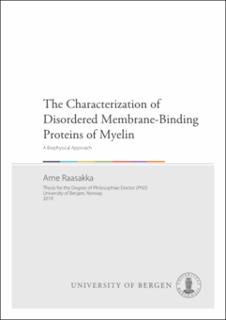| dc.contributor.author | Raasakka, Arne | en_US |
| dc.date.accessioned | 2019-06-11T07:44:57Z | |
| dc.date.available | 2019-06-11T07:44:57Z | |
| dc.date.issued | 2019-04-12 | |
| dc.identifier.isbn | 978-82-308-3520-3 | en_US |
| dc.identifier.uri | https://hdl.handle.net/1956/19951 | |
| dc.description.abstract | Myelin is a multilayered lipid-rich structure that surrounds selected axonal segments in the central and peripheral nervous systems (CNS and PNS, respectively). Myelin insulates axons, which increases nerve conduction velocity by up to two orders of magnitude. The correct formation and stability of myelin are crucial for the function of the nervous system, as demonstrated in the case of demyelinating diseases. The disruption of myelin and its compact structure can result from an autoimmune response, such as in the case of multiple sclerosis (MS), which affects the CNS. Another mechanism arises from mutations, which compromise myelin protein function and lead to disease. Such disorders include PNS neuropathies. Demyelinating conditions are generally chronic, incurable diseases. Remedies for these remain to be developed due to insufficient understanding of the formation and stability of healthy myelin. The insulative nature of myelin arises from a specialized plasma membrane that is wrapped dozens of times around the axon, before myelin undergoes compaction that excludes most water content. Stacked lipid membranes are adhered together by myelin-specific proteins with unique structural and functional properties. Such proteins include the intrinsically disordered myelin basic protein (MBP) and the integral membrane protein, myelin protein zero (P0), in the CNS and PNS, respectively. These proteins are only abundantly expressed in myelin and they are highly conserved within vertebrates. Both MBP and P0 have been linked to demyelinating disorders, with the structural details remaining to be elucidated. In this thesis, a cross-complementary biophysical method ensemble was established and used to characterize the folding, lipid binding, and membrane stacking properties of MBP, uncovering a putative mechanism for MBP-induced formation of compact myelin. The same workflow was used to characterize the cytoplasmic domain of P0 (P0ct), which has been suggested to adhere membranes together in the PNS similarly to MBP in the CNS. Indeed, P0ct behaved similarly to MBP in various lipid environments. The results provide a model for P0-induced membrane stacking in the PNS. The effect of ions on the function of MBP and P0ct was studied, unveiling that Ca2+, the most abundant divalent cation in myelin, modulates their activity. The study was expanded to peripheral neuropathy-related mutant variants of P0ct, and a specific gain-of-function mutation may explain the aberrant myelin phenotype in patients. The biophysical approach described in this thesis enables the characterization of myelin proteins and their disease variants. While well-behaving model lipid conditions were employed here, more physiologically relevant conditions should be studied in the future, possibly by the inclusion additional methods. | en_US |
| dc.language.iso | eng | eng |
| dc.publisher | The University of Bergen | eng |
| dc.relation.haspart | Paper I: Raasakka A., Ruskamo S., Kowal J., Barker R., Baumann A., Martel A., Tuusa J., Myllykoski M., Bürck J., Ulrich A.S., Stahlberg H. & Kursula P. (2017) The Membrane Association Landscape of Myelin Basic Protein Portrays Formation of the Myelin Major Dense Line at the Molecular Level. Scientific Reports 7(1):4974. The article is available at: <a href="http://hdl.handle.net/1956/17446" target="blank"> http://hdl.handle.net/1956/17446</a> | en_US |
| dc.relation.haspart | Paper II: Raasakka A., Ruskamo S., Kowal J., Han H., Baumann A., Myllykoski M., Fasano A., Rossano R., Riccio P., Bürck J., Ulrich A.S., Stahlberg H. & Kursula P. (2019) Molecular structure and function of myelin protein P0 in membrane stacking. Scientific Reports 9(1):642. DOI: 10.1038/s41598-018- 37009-4. The article is available at: <a href="http://hdl.handle.net/1956/19950" target="blank"> http://hdl.handle.net/1956/19950</a> | en_US |
| dc.relation.haspart | Paper III: Raasakka A., Jones N.C., Hoffmann S.V. & Kursula P. (2019) Ionic strength and calcium regulate the membrane interactions of myelin basic protein and the cytoplasmic domain of myelin protein zero. Biochemical and Biophysical Research Communications 511(1):7-12. The article is available in the main thesis. The article is also available at: <a href="https://doi.org/10.1016/j.bbrc.2019.02.025" target="blank">https://doi.org/10.1016/j.bbrc.2019.02.025</a> | en_US |
| dc.relation.haspart | Paper IV: Raasakka A., Ruskamo S., Barker, R., Krokengen O.C., Vatne G.H., Kristiansen C.K., Hallin E.I., Skoda M.W.A., Bergmann U., Wacklin-Knecht H., Jones N.C., Hoffmann S.V. & Kursula P. (2019) Neuropathy-related mutations alter the membrane binding properties of the human myelin protein P0 cytoplasmic tail. The article is available in the main thesis. The article is also available at: <a href="https://doi.org/10.1101/535013" target="blank"> https://doi.org/10.1101/535013</a> | en_US |
| dc.title | The Characterization of Disordered Membrane-Binding Proteins of Myelin. A Biophysical Approach | en_US |
| dc.type | Doctoral thesis | |
| dc.rights.holder | Copyright the author. All rights reserved | |
| dc.identifier.cristin | 1691553 | |
